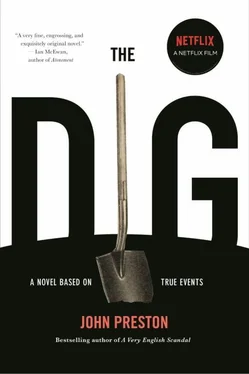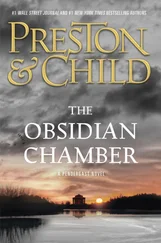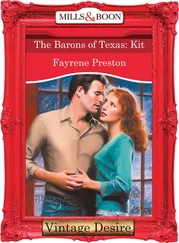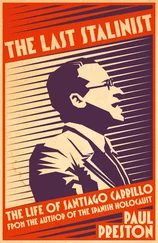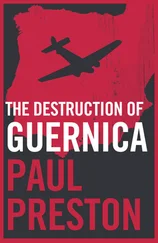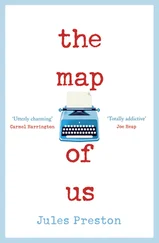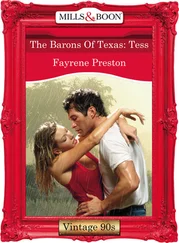Apparently Mrs. Pretty’s nephew preferred sleeping out of doors. Somehow this seemed a very affected thing to want to do, although I didn’t say that either.
Slowly, Phillips made his way down the ladder. Every so often he glanced over his shoulder, almost as if he suspected that he was being observed, before lowering himself onto another rung. At the bottom, he stepped off as lightly as he could, hitching his weight up as a woman might do with her skirts. Walking on the balls of his feet, he moved down the ship until he reached the near end of the burial chamber. Once there, he sank to his knees with a sigh.
Without Stuart’s presence, the atmosphere had changed more than I would have thought possible. Everything was much more serious, more dour, than before. Even at break times there were no lighthearted moments. Scarcely anyone talked to one another; they just buckled down to their appointed tasks. Having finished moving the spoil heaps from one place to another, the men had now been put to work uncovering the last few rivets in the bow section.
When this was finished, they were able to take the first complete measurements of the ship. It was just under ninety feet from one end to the other. The original ship, however, would have been even longer. The last six feet of the stern end is missing, sheared away. Phillips thought that medieval farmers must have been responsible. It was Mr. Brown who suggested the ship might have been deliberately put into the ground at an angle. He believes that the stern protruded above the mound like a great horn, thus ensuring it was clearly visible from the other side of the river. To my surprise, Phillips did not dismiss this theory out of hand, even conceding that it might have some validity to it.
Silently, we continued throughout the afternoon. I was working at the opposite end of the chamber to Phillips. Once in a while, I would look up and see him bent over, his braces stretched and taut. The sun beat down even more fiercely than before.
I was wearing a sleeveless blouse. I could almost see my arms and shoulders turning brown. Practically mahogany. This, though, was no time for vanity. I’d quite stopped caring about my appearance. The only thing that mattered was whatever lay inside the ship.
When Phillips appeared beside me, I gave a start — I couldn’t understand how he had got there without my being aware of it. The sides of his nose were shiny with sweat.
“Have you found anything?” he asked.
I showed him a fragment of what I thought was probably a pottery bottle.
“Nothing else?”
I shook my head. Meanwhile, Phillips kept looking at me in an oddly expectant sort of way.
“Have you found anything, Mr. Phillips?” I asked.
“I think I have,” he said. “Come and have a look if you like.”
As I came closer to his end of the chamber, I saw that Phillips had uncovered an edge of pale gray stone. Two flat surfaces were showing — both smooth and at right angles to one another. So far, he had uncovered about eighteen inches of the same straight pumice-colored, right-angled edge. At either end, the stone disappeared into the sand.
“Whatever this is, he’s a big chap,” Phillips said. “Perhaps we could each start in the middle and work outwards.”
Further clearing revealed that each surface was two inches wide. Once this was done, I moved to my right, following the leading edge along. All the time, I kept expecting to come across a crack or a broken edge. I could not see how such a large object had remained intact — especially if the roof had fallen on top of it. But there was no crack, nor any sign of damage.
Within an hour, the object had grown in length to almost three feet. Still, it was quite uniform and symmetrical, with the edges perfectly smooth. Then, almost immediately, the edges began to taper. I assumed I must be close to one end of it by now. But as quickly as it had tapered off, the stone began to bulge out again. At the same time, the surface became more pitted and undulating. Fortunately, the sand was so dry I was able to brush it away without using the trowel. Phillips too appeared to be nearing the other end. This also tapered and then bulged out again.
Looking across, I saw that Phillips had put on a sudden burst of speed. Sand was flying up on either side of him. But just a few moments later, I noticed that he was no longer brushing. Indeed, he wasn’t doing anything at all. I watched and waited for him to carry on, but still he didn’t move.
I stood up and crossed over to where he was sitting. When I looked down, I gasped in surprise. There, staring back at me, was a man’s face. Its eyes were shut, its mouth pursed and it had a long pointed beard. It looked just like a miniature body lying in the sand. At the same time, though, I kept expecting its eyes to spring open, as if awakening from a long sleep.
Phillips didn’t say anything. He just reached out and stroked the surface of the stone with the tips of his fingers, doing so rather more tenderly than I might have expected.
Soon after resuming, I too uncovered a face. It was identical in size to the first, the shape of an inverted teardrop. This was also bearded — the strands of hair had been picked out in parallel grooves in the stone. But there was a subtle, scarcely definable difference in its expression. Whereas the first face looked penitent, this one looked apprehensive. Fearful of what it might see if it were to open its eyes.
By then Phillips was well on the way to uncovering a second face of his own. Eventually, we had exposed three sides of a long, square-sided piece of stone. At both ends of it, and on each of the surfaces, were bearded faces. All of them with minute variations in expression.
Sliding our trowels underneath the bottom edge of the stone, we inched them along until they met. Next, we dug out a channel so that we could slide our fingers beneath it. Gently we rocked the stone from side to side. When we were as sure as we could be that it wasn’t stuck, we lifted each end on a count of three.
It came out quite easily. But the weight was far greater than I had been expecting. Already damp with sweat, my fingers started to slip on the smooth surface. I called to Phillips that we had to put it down. As we did so, the stone rolled over, exposing the fourth — previously buried — surface. Here were two more faces, one on either end.
These faces had different expressions from the others; they might have been showing various forms of contemplation. All eight, however, were perfectly preserved. Phillips and I were on our hands and knees, face-to-face, with the stone lying between us. Both of us were panting away.
“Do you have any idea what this is?” he asked.
“Some sort of scepter?”
“A scepter, yes.” He nodded. “That’s what I thought.”
“Have you ever seen anything like it before?”
“Never!” he said. “And what’s more, nor has anyone else. As far as I know, this has no parallel. Not in European or Scandinavian archaeology at any rate. There have been stone scepters found in Ireland and Scotland. Only with one face on them, though. Never eight. And never of this size, not remotely.”
He took out his handkerchief and pressed it against his brow. “You know what this means, don’t you?”
I suspected I did know, although at that moment it seemed best not to say so.
“Unless I am very much mistaken,” said Phillips, “this is the grave of a king.”
I dined alone at the Bull. Literally so — there was no one else in the dining room. The menu offered a choice of gammon or smoked haddock. I ordered the gammon. Although this hadn’t been specified on the menu, it came with a fried egg on top. The gammon was sweet and tender, while the egg white slipped down my throat more succulently than an oyster. For pudding, I had a slice of gooseberry pie with cream. It was one of the most delicious meals I had ever eaten.
Читать дальше
